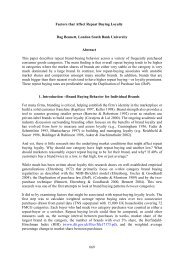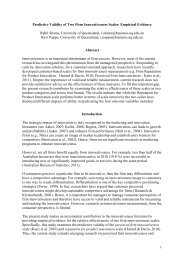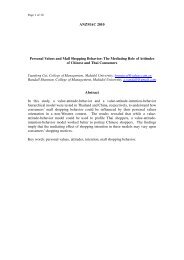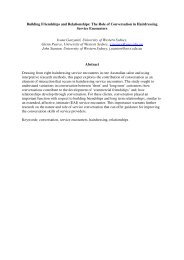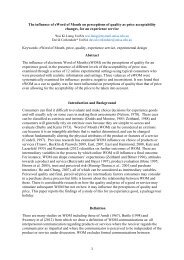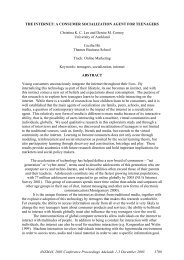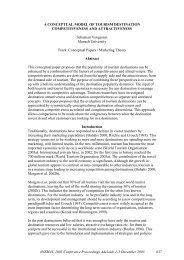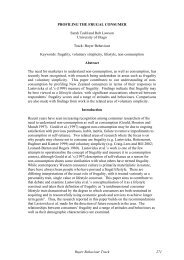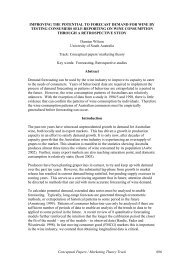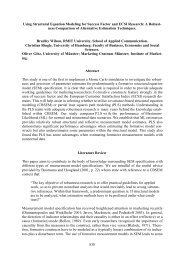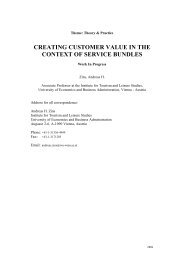Brand Halo: Understanding its Implications ... - ANZMAC
Brand Halo: Understanding its Implications ... - ANZMAC
Brand Halo: Understanding its Implications ... - ANZMAC
Create successful ePaper yourself
Turn your PDF publications into a flip-book with our unique Google optimized e-Paper software.
(Erdem, Swait, & Louviere, 2002), introduction of brand associations and quality<br />
expectations (Van Osselaer & Alba, 2003), among others.<br />
A halo effect in consumer choice would, therefore, relate to the information distortion<br />
introduced in the judgment of alternatives (Russo et al., 1998); in the pursuit of reaching a<br />
final outcome, consumers involuntarily rely on their perceptions about brands, biasing a<br />
rational assessment of specific attributes. Beckwith and Lehmann (1975) point out that<br />
individuals who favour an alternative tend to rate it high on all desirable attributes, whereas,<br />
disliking that alternative influences in making specific attributes more negatively assessed,<br />
possibly in pursuit of evaluative consistency (Ajzen, 2005). <strong>Brand</strong> halo would be the<br />
component of <strong>Brand</strong> Equity that “blinds” consumers into assuming aspects of products of a<br />
specific brand are better/worse than others, in line with the global assessment of that brand.<br />
<strong>Implications</strong> of this phenomenon suggest that consumers are unable to rationally judge the<br />
alternatives presented, and interpretation, rather than the functional attribute, plays an ever<br />
important role in consumer judgment, contrary to what is expected from the rationaleconomic<br />
view. Managerially, this effect highlights the role brand equity exerts in addressing<br />
shortcomings of specific aspects of products.<br />
Additionally, when products are described by a myriad of specifications and consumers can<br />
only hope to grasp comprehension of a handful for undertaking a choice, a valuable brand<br />
impression would provide an advantageous starting ground, independently of the aspect being<br />
analysed. Russo and colleagues (Russo et al., 1998) point out the risk of consumers selecting<br />
an inferior alternative due to judgment bias introduced in the selection task.<br />
The objective of this paper is to develop a conceptual foundation across choice-related<br />
disciplines to investigate the role of brand halo in consumer choice. Defining this component<br />
and <strong>its</strong> moderating variables enables a deeper understanding of this phenomenon and<br />
facilitates further research into validating <strong>its</strong> adequacy to consumer choice studies, measuring<br />
<strong>its</strong> impact in a given choice task, and identifying <strong>its</strong> boundary conditions and constructs<br />
related. The development of this topic will take place in the following sections.<br />
<strong>Brand</strong> <strong>Halo</strong> and Choice<br />
Humans strive for mental coherence: a cognitive response to a state of psychological conflict.<br />
This pursuit is justified differently according to various streams of social psychology, ranging<br />
from conceptualizing it as an instrument to avoid cognitive dissonance to claims that it is an<br />
almost inevitable consequence of the way the human brain functions (Ajzen, 2005). Psychic<br />
tension is resolved by the readjustment of cognitive or affective aspects of an assessed<br />
element towards a coherent evaluative attitude behaviourally consistent (Ajzen, 2005).<br />
The classic approach in social psychology contends that different sources of information<br />
provide the input for the construction of personal beliefs, which in turn are concatenated to<br />
produce an attitude towards the elements assessed. In a marketplace, a decision-maker<br />
constructs beliefs regarding products, which provide a foundation for the construction of an<br />
overall attitude towards this alternative (Leuthesser, Kohli, & Harich, 1995).<br />
The classic perspective of attitude formation is consistent with economic studies and multiattribute<br />
attitudinal models: their premise is to decompose the value of a product into<br />
observable parts and measure how these specific aspects weight on the attitude regarding a<br />
product/ brand (Beckwith & Lehmann, 1975; Meyer, 1981). Random-Utility Models aim to



